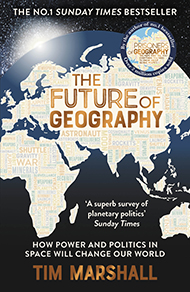“Ultimately, the picture Tim Marshall paints is not a cheery one. The emergence of great power competition has heralded another space race. What is most concerning to Marshall, however, is that unlike the last time round, the great powers are now able to inflict catastrophic damage on one another in, or from, space.” – The CHACR takes one giant leap into The Future of Geography.
Read the digital document above or continuing reading below.
WAR’S FINAL FRONTIER
TITLE: The Future of Geography: How Power and Politics in Space Will Change our World
AUTHOR: Tim Marshall
REVIEWER: Captain Ben Tomlinson, Visiting Fellow, CHACR
There are few writers as familiar and relevant to the British Army as Tim Marshall. His 2015 Prisoners of Geography has formed the basis of course reading lists across Defence and provided a generation of Westbury-bound officer candidates with the geopolitical insights to realise their ambitions. Since then, Marshall’s works, which also include Worth Dying For (2016), Divided (2018), and The Power of Geography (2021), have been a regular theme of millions of conference calls.
 The author’s most recent offering, The Future of Geography: How Power and Politics in Space Will Change Our World, follows a well-tested and much lauded formula for success, but focuses its insights on the risks and opportunities of an “era of Astropolitics”. As Marshall reflects, “each time humanity has ventured into a new domain it has brought war with it” and there is no reason to doubt the opportunities presented by space.
The author’s most recent offering, The Future of Geography: How Power and Politics in Space Will Change Our World, follows a well-tested and much lauded formula for success, but focuses its insights on the risks and opportunities of an “era of Astropolitics”. As Marshall reflects, “each time humanity has ventured into a new domain it has brought war with it” and there is no reason to doubt the opportunities presented by space.
Ultimately, the picture Marshall paints is not a cheery one. The emergence of great power competition has heralded another space race, in which we are presently engaged – apparently. What is most concerning to Marshall, however, is that unlike the last time round, the great powers are now able to inflict catastrophic damage on one another in, or from, space. This capability therefore presents several issues. If space is the global commons we identified it as in the late 20th Century, then what rights do nations have to establish permanent military capabilities within that sphere? What rights do adversaries have to attack them? And what rights do we have to defend them? As Marshall expands; in 2004, during the Iraq War: “68% of US munitions fired were guided by satellites, of which 80% were commercial. If Iraq had possessed the capability, would it have been within its rights to fire at those satellites?”
The hypotheticals posed within The Future of Geography are only exacerbated by the emergence of space’s commercial sector. As an industry, space is predicted to explode in popularity. Having generated $450 billion in 2022, it is expected to create revenues of more than $1 trillion by 2040. Commercial opportunities such as space tourism or mining for rare and valuable materials all present moral dilemmas upon which any state actor could object. In turn, many of these friction points remain ungoverned, and what space laws and treaties currently exist “are horribly out of date and too vague for current conditions”.
Overall, The Future of Geography is a worthy successor to Marshall’s finest offerings. The historical context, legal dilemmas and geopolitical implications of space exploration are beautifully summarised for even the most casual reader, and neatly packaged for regurgitation by every officer commanding in the Army. Definitely worth a read.
Published by Elliott & Thompson, Paperback, £9.99, ISBN: 9781783967247





